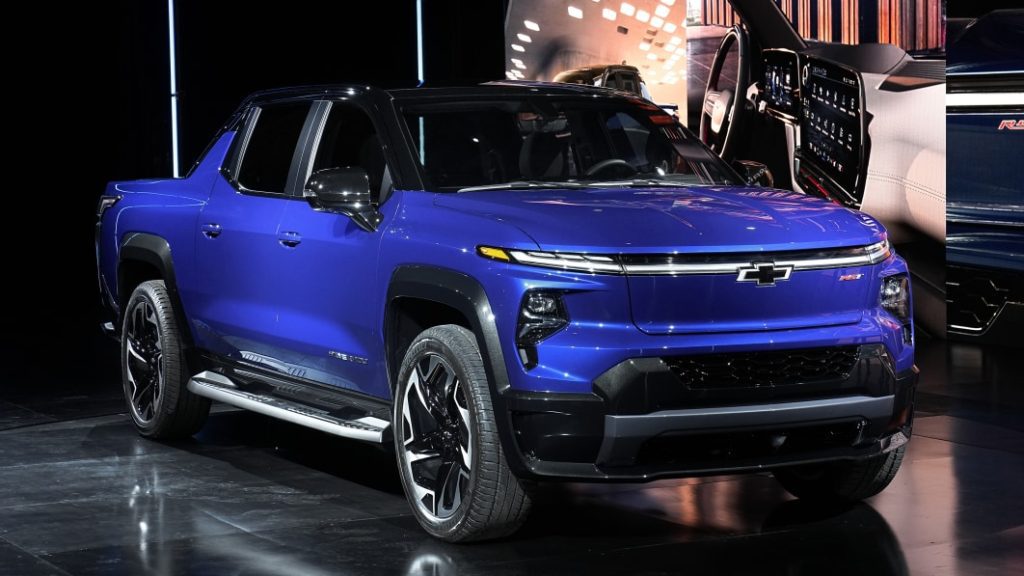GM CEO Mary Barra says electric vehicles to be profitable by 2025

General Motors says it expects its portfolio of electric vehicles to turn a profit in North America by 2025 as it boosts battery and assembly plant capacity to build over 1 million EVs per year.
CEO Mary Barra used the pledge to kick off the company’s investor day event Thursday in New York.
The profit figure includes vehicle sales revenue, benefits from emissions tax credits, and revenue from software and parts sales, she said.
Barra said the company’s EV portfolio appeals to a broader range of customers than the competition.
GM’s EV lineup includes plans to sell a small SUV for around $30,000, plus a luxury SUV, pickup trucks, and Hummer SUVs in the next two years.
The Detroit automaker has a goal of selling only electric passenger vehicles by 2035.
GM is sticking by a pledge made by Barra to sell more EVs in the U.S. than market leader Tesla by the middle of the decade.
“Our commitment is to lead the industry,” Chief Financial Officer Paul Jacobson told reporters ahead on the investor day event. “We believe that with the infrastructure that we put in place and the vehicles that you’ll see today, we’ll be able to get there.”
A more realistic view
The profit forecast for electric vehicles seemed to be a step back from earlier predictions that a new generation of GM EVs would make money from the start.
But GM said earlier predictions of immediate profitability didn’t include the capital costs of switching to the new technology. The 2025 profit prediction is on a pretax basis that includes the capital costs of building battery factories and converting internal combustion plants to electric vehicles.
Jacobson said it will take time for individual electric vehicles to get to “low- to mid-single digit” profit margins in 2025 as costs are spread over more vehicles. “If you look at any individual (vehicle) program, there’s probably better performance than what you see in the aggregate as a whole,” he said.
EV profit margins will go even higher once clean energy tax credits from the federal Inflation Reduction Act are applied, Jacobson said.
Despite economic volatility and the possibility of a downturn, GM appeared a little more confident in this year’s financial results, saying Thursday it expects full-year pretax income to be $13.5 billion to $14.5 billion. That’s within the range of previous guidance of $13 billion to $15 billion. The forecast for free cash flow, the cash left after operating and capital expenses, $7 billion to $9 billion to $10 billion to $11 billion for the year.
GM also said its Brightdrop commercial vehicle unit, which is making electric vans and carts, will contribute over $1 billion of revenue next year.
Shares of GM rose slightly Thursday as the broader markets declined.
As for the new vehicles, GM will roll out an all-electric version of the Chevrolet Corvette next year, President Mark Reuss said.
“This will again set the standard of the world for performance,” he said.
A rundown of what’s new
Reuss gave glimpses of other new or revamped GM vehicles that are coming in the next two years. New internal combustion vehicles will be based on the existing underpinnings, saving costs, yet allowing the company to do significant upgrades, he said.
Among the revamped or new entries next year are the Chevrolet Traverse three-row SUV, as well as a new Buick SUV, and a revamped Chevrolet Trax small SUV starting around $19,000.
In 2024, GM will redo the three-row GMC Acadia SUV, making it more truck-like, Reuss said. Then it will revamp the internal combustion version of the Chevy Equinox small SUV in the biggest market segment in the world.
For electric vehicles next year, GM will revive the Buick Electra name for a new SUV that will go on sale first in China, then in the U.S. Then comes the Cruise Origin, a multi-passenger vehicle built for the company’s ride-hailing service, and a Cadillac compact SUV.
Among the 2024 EVs is the GMC Sierra full-size pickup., a full-size Cadillac SUV, and full-size Buick and Chevrolet electric cars mainly for China.
Online buying (the savings go to GM)
Reuss also said GM is revamping the way customers buy electric vehicles, giving them the option of fully purchasing online or at the dealership and saving the company $2,000 per vehicle.
Rather than dealers holding huge inventories, they would keep fewer vehicles on their lots. When a customer orders an EV, it would come from three distribution centers on the U.S. coasts. The centers, two in California and one in Georgia, would stock popular equipment combinations and allow deliveries in as little as four days, Reuss said.
The system would automate a lot of financing and insurance costs.
“This will translate into that $2,000 per unit in efficiencies and cost reductions for GM,” he said, adding that the savings would go to GM.
Reuss also took a shot at U.S. electric vehicle sales leader Tesla, telling analysts that more than 11,000 Tesla owners had their vehicles serviced at a GM dealership. He said the dealer network is a big competitive advantage for service.



